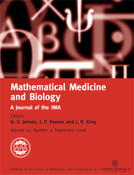-
Views
-
Cite
Cite
Seyed M. Moghadas, Murray E. Alexander, Bifurcations of an epidemic model with non-linear incidence and infection-dependent removal rate, Mathematical Medicine and Biology: A Journal of the IMA, Volume 23, Issue 3, September 2006, Pages 231–254, https://doi.org/10.1093/imammb/dql011
Close - Share Icon Share
Abstract
An epidemic model with a generalized non-linear incidence is extended to incorporate the effect of an infection-dependent removal strategy, which is defined as a function of the number of infected individuals. It is assumed that the removal rate decreases from a maximum capacity for removing infected individuals as their number increases. The existence and stability of the associated equilibria are analysed, and the basic reproductive number (
[graphic: see PDF]
) is formulated. It is shown that
[graphic: see PDF]
is independent of the functional form of the incidence, but depends on the removal rate. Normal forms are derived to show the different types of bifurcation the model undergoes, including transcritical, generalized Hopf (Bautin), saddle-node and Bogdanov–Takens. A degenerate Hopf bifurcation at the Bautin point, where the first Lyapunov coefficient vanishes, is discussed. Sotomayor's theorem is applied to establish a saddle-node bifurcation at the turning point of backward bifurcation. The Bogdanov–Takens normal form is derived, from which the local bifurcation curve for a family of homoclinic orbits is formulated. Bifurcation diagrams and numerical simulations, using parameter values estimated for some infectious diseases, are also presented to provide more intuition to the theoretical findings. The results show that sufficiently increasing the removal rate can reduce
[graphic: see PDF]
below a subthreshold domain, which leads to disease eradication.





